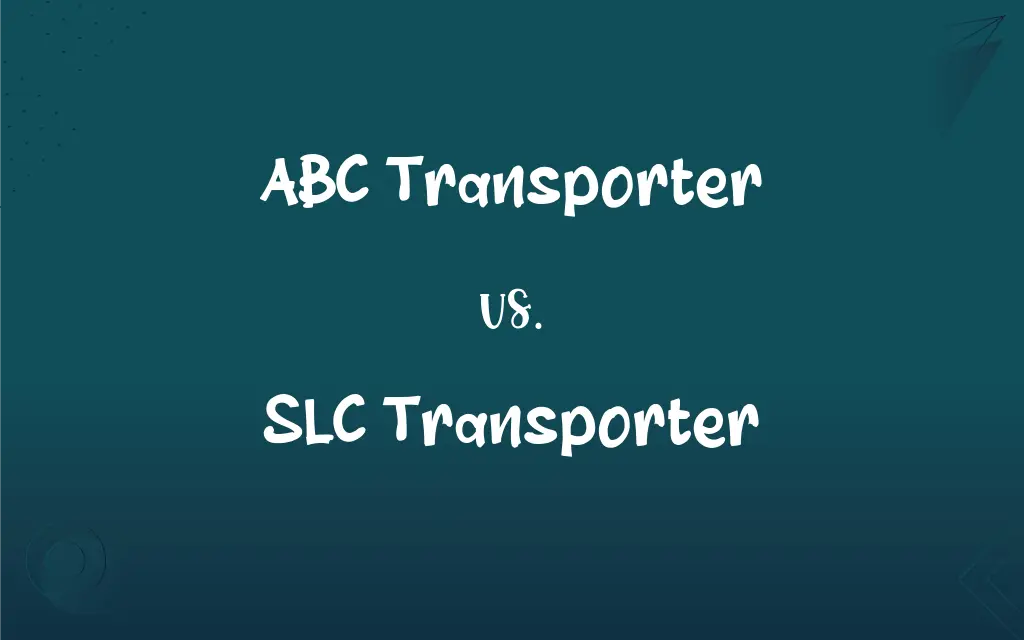ABC Transporter vs. SLC Transporter: What's the Difference?
Edited by Janet White || By Harlon Moss || Published on February 18, 2024
ABC transporters are membrane proteins that use ATP to transport substances across cell membranes, while SLC transporters are solute carriers that often rely on ion gradients.

Key Differences
ABC transporters, short for ATP-Binding Cassette transporters, actively transport a variety of molecules across cellular membranes using ATP as an energy source. SLC transporters, known as Solute Carrier transporters, typically move molecules across membranes by facilitated diffusion or secondary active transport, often relying on ion gradients rather than ATP.
ABC transporters are involved in processes like drug resistance, lipid transport, and ion channel regulation. In contrast, SLC transporters play a key role in nutrient uptake, neurotransmitter transport, and ion homeostasis.
In terms of structure, ABC transporters have a characteristic ATP-binding cassette domain. SLC transporters, on the other hand, have diverse structures adapted to their specific substrates and transport mechanisms.
ABC transporters are notable for their role in multidrug resistance in cancer cells, where they pump out drugs, reducing their effectiveness. SLC transporters are essential for cellular metabolism, including glucose transport by GLUT transporters, a subgroup of SLCs.
Genetic defects in ABC transporters can lead to diseases like cystic fibrosis and Tangier disease. Similarly, mutations in SLC transporters are linked to conditions like diabetes and amino aciduria.
ADVERTISEMENT
Comparison Chart
Energy Source
ATP (Adenosine Triphosphate)
Ion gradients
Function
Drug resistance, lipid transport
Nutrient uptake, ion homeostasis
Structural Feature
ATP-binding cassette domain
Diverse structures for specific substrates
Role in Disease
Multidrug resistance, cystic fibrosis
Diabetes, amino aciduria
Transport Mechanism
Active transport
Facilitated diffusion, secondary active transport
ADVERTISEMENT
ABC Transporter and SLC Transporter Definitions
ABC Transporter
Genetic defects in ABC transporters can cause diseases like cystic fibrosis.
Mutations in the CFTR, an ABC transporter, are responsible for cystic fibrosis.
SLC Transporter
SLC transporters participate in nutrient uptake and neurotransmitter transport.
SLC transporters are essential for amino acid absorption in the intestine.
ABC Transporter
ABC transporters are involved in lipid transport and ion channel regulation.
ABC transporters regulate cholesterol levels in the cell.
SLC Transporter
SLC transporters have diverse structures tailored to specific substrates.
The unique structure of each SLC transporter determines its substrate specificity.
ABC Transporter
ABC transporters are membrane proteins that use ATP to transport various substances.
The ABC transporter played a key role in drug efflux from cancer cells.
SLC Transporter
SLC transporters are a family of membrane proteins that transport solutes using ion gradients.
SLC transporters facilitate glucose uptake into cells.
ABC Transporter
ABC transporters have a characteristic ATP-binding domain.
The ATP-binding cassette is crucial for the ABC transporter's function.
SLC Transporter
Mutations in SLC transporters can lead to metabolic disorders.
Genetic alterations in SLC transporters are linked to diabetes.
ABC Transporter
ABC transporters contribute to multidrug resistance.
Overexpression of certain ABC transporters can lead to chemotherapy failure.
SLC Transporter
SLC transporters are critical for maintaining ion homeostasis.
SLC transporters regulate sodium and potassium levels in neurons.
FAQs
Are ABC transporters involved in drug resistance?
Yes, they play a key role in multidrug resistance.
What do ABC transporters transport?
ABC transporters transport a variety of molecules, including drugs, lipids, and ions.
Do SLC transporters require ATP?
No, they typically use ion gradients for transport.
Are SLC transporters involved in any diseases?
Yes, mutations in SLC transporters are linked to conditions like diabetes.
What is a key structural feature of ABC transporters?
Their key feature is the ATP-binding cassette domain.
What types of substances do SLC transporters move?
They transport a variety of solutes, including glucose, amino acids, and ions.
What role do ABC transporters play in cancer?
They can contribute to chemotherapy resistance in cancer cells.
What is the primary function of SLC transporters?
SLC transporters primarily facilitate the transport of nutrients, ions, and neurotransmitters.
How do ABC transporters get energy for transport?
They use ATP hydrolysis for energy.
Can mutations in ABC transporters cause diseases?
Yes, such mutations can lead to diseases like cystic fibrosis.
Do ABC transporters only transport harmful substances out of cells?
No, they transport a variety of substances, not just harmful ones.
Is there a difference in the number of ABC and SLC transporters in the human genome?
Yes, the human genome contains different numbers of each, reflecting their varied roles and mechanisms.
Are there disorders associated with overactivity of ABC transporters?
Overactivity of certain ABC transporters is associated with multidrug resistance in cancer treatment.
How do SLC transporters maintain ion balance?
By regulating the transport of ions across cell membranes.
What is an example of an ABC transporter?
The CFTR protein involved in cystic fibrosis is an example.
Can SLC transporters be targeted by drugs?
Yes, they are targets for various drugs, including those for diabetes.
How are SLC transporters structured?
They have diverse structures adapted to their specific substrates.
Are ABC transporters specific to humans?
No, they are found in a wide range of organisms.
Do all cells have SLC transporters?
Most cells have various types of SLC transporters based on their specific functions.
Can both ABC and SLC transporters be involved in the same cellular process?
Yes, in some pathways, both types of transporters work together for effective substance transport and cellular homeostasis.
About Author
Written by
Harlon MossHarlon is a seasoned quality moderator and accomplished content writer for Difference Wiki. An alumnus of the prestigious University of California, he earned his degree in Computer Science. Leveraging his academic background, Harlon brings a meticulous and informed perspective to his work, ensuring content accuracy and excellence.
Edited by
Janet WhiteJanet White has been an esteemed writer and blogger for Difference Wiki. Holding a Master's degree in Science and Medical Journalism from the prestigious Boston University, she has consistently demonstrated her expertise and passion for her field. When she's not immersed in her work, Janet relishes her time exercising, delving into a good book, and cherishing moments with friends and family.































































